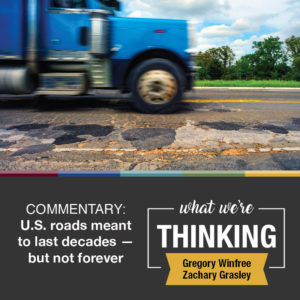 By: Gregory Winfree and Zachary Grasley
By: Gregory Winfree and Zachary Grasley
The subject of our nation’s infrastructure is once again prominent, both in the wake of the recent release of the American Society of Civil Engineers quadrennial report card on the state of America’s infrastructure and among our policymakers in Washington, D.C.
The ASCE report card presents one of those classic blends of good news and bad for the fundamental transportation network so integral to our daily existence.
The good: Our grade for all 17 categories collectively is better than the mark from four years ago. The bad: It’s still unacceptable. Limping forward from a D-plus overall to a C-minus wouldn’t earn much praise from the parent of a high schooler, and it shouldn’t garner kudos from anyone who values reliable transportation, either.
The road system we rely upon so heavily saw no improvement in its grade of D from four years ago. The same is true of the D-minus for transit systems. The bridges’ grade fell by a notch to a C since that time, and airports moved up one step to a D-plus.
The picture is further dimmed because our transportation network is only one piece of the broader framework of physical assets that enable our modern comfort and convenience. And we have seen all too vividly (and recently) what happens when that underpinning set of systems is disrupted.
When we flip a switch and nothing happens, we know something’s wrong. When we turn a faucet and nothing comes out of it, we know we’re in trouble.
Though we typically don’t have similar immediate signs to signal a road and bridge crisis, you can be assured the urgency is there; deterioration creeps along at a glacial pace until something gives — like the corrosive wear and tear on highways in West Texas, Pennsylvania and the Dakotas due to heavy truck traffic fueled by the energy boom.
Much of our transportation infrastructure in America has been in place for half a century or more, and it’s simply wearing out. There’s clearly a gap between the amount of transportation funding we need and the amount we have within reach. Limited investment, growing demand and rising highway construction costs create a gathering storm to widen that chasm every year.
This is a big problem sharing space with a lot of other big problems in our country. Look no further than the cost of a pandemic recovery to see that massive challenges carry equally hefty price tags. The cost of upgrading our national infrastructure will be no different — $2.5 trillion over 10 years, according to ASCE. Part of that involves making our transportation network more resilient than before — not only able to be restored quickly after a disaster, but better fortified to withstand the disaster in the first place.
As enormous as that cost sounds, the only thing more expensive would be the cost of doing nothing. The longer we postpone the needed work, the higher the price will be.
On a personal scale, what we face is no different than the needs of maintaining our homes. When your roof is weakened by leaks, you can pay the repair price in return for stability and peace of mind. Or you can defer the maintenance and spend the money elsewhere, risking a much larger expense when a tree limb falls and the roof collapses, taking a ceiling along with it.
Some of us might remember the TV advertisement from the 1970s. “You can pay me now, or pay me later,” the mechanic said. He was talking about car upkeep, but the reasoning applies to our national infrastructure as well.
If there’s anything that keeps us up at night, it’s that our road and bridge system, top to bottom, has not received the attention that it needs. And the underlying issues are only getting worse.
Even so, we remain hopeful Congress will prioritize the needs of our transportation infrastructure. Our confidence stems not only from a sense of optimism that America can do this, but also from a stark realization that we cannot afford not to.
Our nationwide system of roads and bridges was built to last. It just wasn’t built to last forever.
Gregory Winfree is the agency director of the Texas A&M Transportation Institute and a former U.S. assistant secretary of Transportation. Zachary Grasley is a professor at Texas A&M University’s College of Engineering and director of the Center for Infrastructure Renewal.
This article was originally published in the San Antonio Express-News, May 21, 2021. NOTE: Article may be behind a paywall.